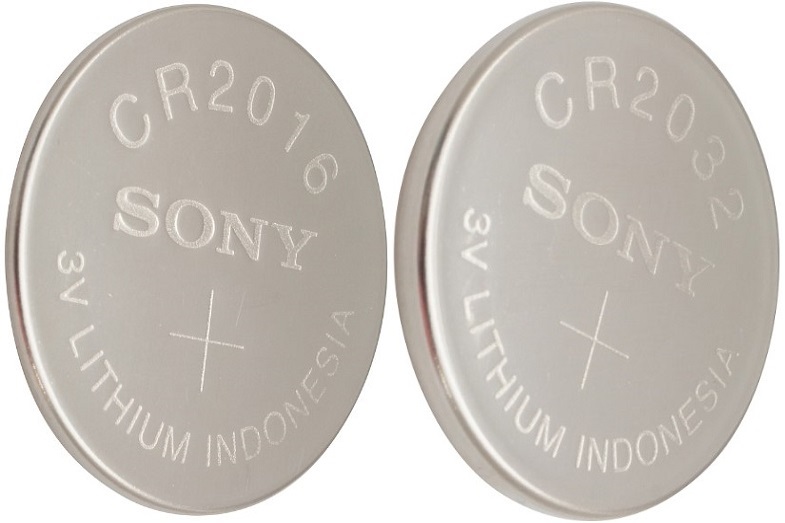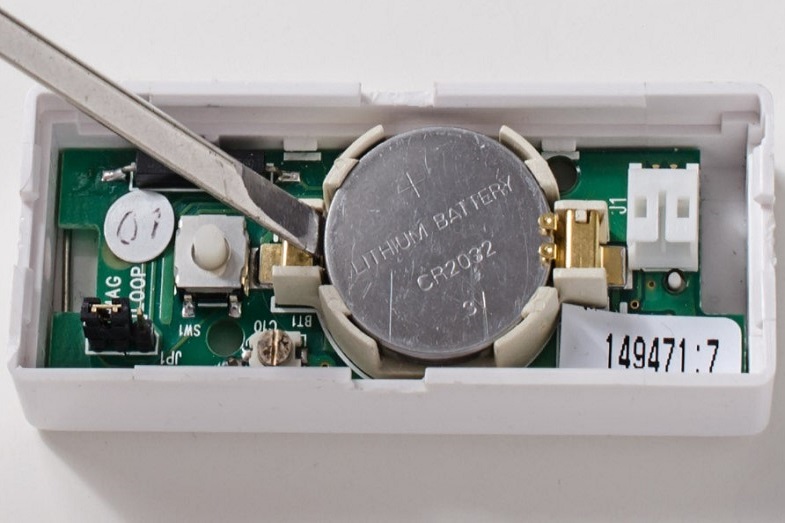When you look at the CR2016 and CR2032 batteries, they look fairly similar; however, there is a slight difference between them. What is the difference between the CR2016 vs CR2032 battery?
Both the CR2016 and the CR2032 batteries have the same diameter, which is 20 mm. They also generate the same 3 volts. The difference between them is that the CR2016 is thinner than the CR2032. The CR2016 battery is 1.6 mm thick, while the CR2032 battery is 2.0 mm thick.
While the CR2016 battery and the CR2032 battery have the same diameter and both can produce the same amount of volts, you cannot interchange them because they don’t have the same thickness. One physical reason is that the battery holder for one may not be the same holder size for the other.
Read on to learn more about the differences between the CR2016 vs CR2032, their similarities, their uses, and how long their service lives are.
CR2016 Vs CR2032
The CR2016 battery is thinner than the CR2032 battery. The CR2016 battery is 1.6 mm thick, while the CR2032 battery is 2.0 mm thick. They both have the same diameter and generate the same 3 volts.
If a battery has the prefix CR, most probably, it is a manganese dioxide lithium battery. It is a type of battery classification of the CR2016 and CR2032. They are mostly used to power consumer gadgets, such as watches, timers, key fobs, computers, and many more. The reason they are very common is that they are generally inexpensive and long-lasting.
These two batteries are generally called button cell batteries or coin-type batteries. But they don’t have the same identification numbers; one is CR2016, while the other is CR2032. There are also other differences between them.
The following are the differences between CR2016 and CR2032:
1. CR2016 Vs CR2032 Battery Cell Numbers
These two batteries have different identifying numbers. Their respective numbers have a specific meaning. The first two digits mean the battery’s diameter in millimeters, while the last two digits denote its thickness, which is also in millimeters.
CR2016 has a 20 mm diameter and a 1.6 mm thickness, while CR2032 has a 20 mm diameter and a 3.2 mm thickness. In other words, while they both have the same diameter, the CR2032 has two times the thickness of CR2016.
2. They Are Not Interchangeable
If CR2016 has half the thickness of CR2032, is it possible to stack up two CR2016 pieces to replace a busted CR2032? No, you can’t do that. Both batteries can generate 3 volts. That means a CR2016 can produce the same volts as the CR2032.
So if you stack up two pieces of CR2016 in place of the worn-out CR2032, the batteries will generate 6 volts instead of just 3. It will be detrimental to the device you are operating because it needs a power source that provides no more than 3 volts.
In other words, although the battery holder may be able to accommodate the two pieces of CR2016, the generated voltage may damage the electronic circuit of the device you are running.

3. They Don’t Have the Same Capacity
A battery’s capacity is measured in milliampere-hour or mAh. It is the amount of charge that the battery can store. The amount of charge is dependent on the mass or volume of the active material inside the battery cell.
An average CR2016 battery has a capacity of around 90 mAh. It means this battery will last for approximately six hours if you are using it with a 15 mA load.
In the case of the CR2032 battery, its capacity is around 240 mAh. It means this battery can last approximately 10 hours if you use it with a 24 mA load.
4. CR2032 Vs CR2016 Battery Thickness
The thickness of a coin-type battery is given in millimeters. And the last two digits of a battery’s identifying number represent the thickness of CR-series batteries. So, for the CR2016 battery, the thickness is 1.6 mm. And the thickness of the CR2032 battery is 3.2 mm, double that of the CR2016.
These two batteries are only similar in three aspects. They are the same in diameter (with both having 20 mm diameters), both of them can generate 3 volts, and both are disposable, meaning you can’t recharge them. These two battery types contain lithium ions, which could spill if you attempt to recharge them.
What Is a CR2016 Battery?
You could have been using the CR2016 battery for a long time without you being aware of it. It is most commonly used to power most modern small and portable electronic gadgets. The shelf life of this battery could last as long as 8 to 10 years.
This battery can provide continuous voltage to electronic devices, providing safe and reliable operation. It’s also temperature-resistant and can withstand even the most harmful changes in temperature.
Uses of CR2016 Battery
Another term for CR2016 battery is ‘button cell’ that can run small portable electric gadgets, such as pocket calculators and small watches. You can also call these batteries ‘coin cells’ because they are similar to small coins.
Electronic devices that use these coin-type batteries have designs that provide long service lives. Usually, CR2016s can last more than a year of continuous use, such as in wristwatches.
These batteries also have low self-discharge rates; therefore, you can expect them to last many years when not in use. But when you use them in electronic devices that require higher capacities, they will run out of juices in a short time.
The most common uses of CR2016 batteries are for powering digital watches, fitness appliances, electronic timers, calculators, car key remotes, kid’s toys, special medical devices, and many more. You often use this type of battery in pairs instead of just one, like in LED flashlights.
How Long Do CR2016 Batteries Last?
CR2016 batteries typically have shelf lives of six years. But one battery manufacturer claims that its single-use silver-zinc battery has a 10-year shelf life. If you read watch manuals, especially those from G-Shock watches, they say that a CR2016 can power the device for two years.
Some believe that they are just a conservative estimate. If you don’t use the auto EL light function, the hourly chime, or the alarm in your watch, the battery could last about seven years or more. This is based on real-life experiences of consumers using their electronic watches powered by CR2016 batteries.
In our comparison of the cr2032 vs cr2016, we’ve looked at the CR2016 battery; next, let’s look at the CR2032 battery.
What Is a CR2032 Battery?
The CR2032 battery is also a coin-type lithium-ion battery that can produce 3 volts. It is popularly known as the CMOS (complementary metal-oxide-semiconductor) battery. You can also use these batteries for powering a computer’s BIOS or the real-time clock of computers.
The identification number CR2032 is an International Electrochemical label. It is called 5004LC by the National Electronics Distributors Association (NEDA) and the American National Standards Institute (ANSI).
In specific terms, the CR2032 is a battery made of lithium-manganese dioxide (LiMnO2). Its anode is made of lithium, and its cathode is made of manganese dioxide. The temperature range that this battery can operate is from -20°C to + 70°C (-4°F to + 158°F).
This battery has a low self-discharge rate, so you can store it for years and retain most of its original charge.

Uses of CR2032 Batteries
The CR2032 battery is typically used in providing power to electronic subsystems that require ultra-low power, like oscillators and real-time clocks. Their design offers low power even if the system power that runs the device is turned off.
As such, their common use is to power the real-time clocks of computer motherboards. They also function as a real-time clock (RTC) and non-volatile BIOS memory backup batteries. The design of modern electronic devices is to prevent drawing power from the CR2032.
How Long Does a CR2032 Battery Last?
Normally, if you use it in computers and other electronic devices, it could last up to two years before it dies. You can calculate the battery life of a CR2032 by dividing its total charge in mAh with its current consumption.
If the device is drawing 1 microamp or less continuously, a CR2032 can last for ten years. This can be possible in situations where the CR2032 is just powering the computer BIOS. However, in most situations, the battery is called to supply more current in pulses or even in a continuous manner.
During normal operations of electronic devices, subsystems such as the RTCs are powered by the device’s main power supply instead of the CR2032 (as long as the device is running). So, more often than not, the device is already worn out, while the CR2032 inside it is still good and operational.
We’ve discussed the difference between the CR2016 vs CR2032 battery; now, let’s take a look at a brief history of coin-type batteries.
History of Coin-Type Batteries Including the CR2016 and CR2032
The very first battery cell was invented by Alessandro Volta, as far back as 1799. But while Volta’s fundamental concepts were followed in subsequent battery developments, his first battery design underwent a lot of changes, improvements, and innovations, up to our modern times when battery coins were developed.
Button cells were developed in tandem with the first electric watch movement. Arthur Fillinger developed the Model 500, the first electronic watch, in 1951. He asked 40 battery makers to produce a small battery to power his watch, but they all turned him down.
However, there was one battery maker that agreed to do it – Union Carbide. Thus, the 301 (SR43SW) battery was born. It was later replaced by the 387S. These were mercury button cells that produced 1.35 volts. Their cells are composed of mercuric oxide with leads made of zinc.
However, the use of mercury was discontinued because it was considered then, even now, as an environmental hazard. They replaced it with silver oxide. The batteries made with this material generated 1.55 volts. This battery became the industry standard and is used in coin batteries to this day, including the cr2016 and 2032 batteries.
Two requirements influenced the development of button batteries back then. One is that they should be low profile, and the other is that they should provide long service lives. The overall requirement is that they should be able to provide power 24/7 for one year or even longer.
These power demands can be satisfied with lithium and alkaline batteries that produce 3 volts and 25 to 210 mAh. Thus, the button batteries that power your electronic gadgets can now support your electronic activities continuously and for a long time.
Conclusion – CR2032 Vs CR2016
CR2016 vs CR2032 – how do they compare? Both the CR2016 and the CR2032 have the same diameter, which is 20 mm. Their significant difference is in their thickness. The CR2016 battery is 1.6 mm thick, while the CR2032 battery is 2.0 mm thick.
Both batteries can produce 3 volts. But since they don’t have the same thickness, you can’t interchange them. You can’t also stack up two CR2016 to replace one CR2032. If you do it, you will generate 6 volts, which would be disastrous to the gadget you are using.
Related reading:
eMMC vs HDD – What is the Difference? Which is Better?
Online Virtual Machine – What Is It? (Free or Paid)



